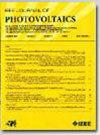A Novel Method for Performance Estimation of PV Modules Using Equivalent Irradiance and Temperature
IF 2.6
3区 工程技术
Q3 ENERGY & FUELS
引用次数: 0
Abstract
The yield of photovoltaic (PV) modules is influenced by various environmental factors, particularly solar irradiance and temperature. However, the measured solar irradiance does not accurately represent the real light intensity absorbed by different types of solar cells, and the measured temperature does not represent the actual cell temperature in PV modules. In this article, equivalent irradiance and temperature are proposed and used to improve the accuracy of output performance estimation of PV modules. First, equivalent irradiance and temperature under different operating condition are obtained by fitting measured利用等效辐照度和温度估算光伏组件性能的新方法
光伏(PV)组件的产率受到各种环境因素的影响,特别是太阳辐照度和温度。然而,测量到的太阳辐照度并不能准确地代表不同类型太阳能电池吸收的真实光强,测量到的温度也不能代表光伏组件中电池的实际温度。本文提出了等效辐照度和等效温度来提高光伏组件输出性能估计的准确性。首先,利用保证收敛粒子群算法对实测I-V数据进行拟合,得到不同工况下的等效辐照度和温度;其次,利用人工神经网络(ANN)模型建立等效辐照度与温度及环境因子之间的关系。提出了两种输入矢量不同的人工神经网络来计算等效辐照度和等效温度。通过四种不同类型光伏组件在广泛工况下的实验数据验证了所提方法的准确性。
本文章由计算机程序翻译,如有差异,请以英文原文为准。
求助全文
约1分钟内获得全文
求助全文
来源期刊

IEEE Journal of Photovoltaics
ENERGY & FUELS-MATERIALS SCIENCE, MULTIDISCIPLINARY
CiteScore
7.00
自引率
10.00%
发文量
206
期刊介绍:
The IEEE Journal of Photovoltaics is a peer-reviewed, archival publication reporting original and significant research results that advance the field of photovoltaics (PV). The PV field is diverse in its science base ranging from semiconductor and PV device physics to optics and the materials sciences. The journal publishes articles that connect this science base to PV science and technology. The intent is to publish original research results that are of primary interest to the photovoltaic specialist. The scope of the IEEE J. Photovoltaics incorporates: fundamentals and new concepts of PV conversion, including those based on nanostructured materials, low-dimensional physics, multiple charge generation, up/down converters, thermophotovoltaics, hot-carrier effects, plasmonics, metamorphic materials, luminescent concentrators, and rectennas; Si-based PV, including new cell designs, crystalline and non-crystalline Si, passivation, characterization and Si crystal growth; polycrystalline, amorphous and crystalline thin-film solar cell materials, including PV structures and solar cells based on II-VI, chalcopyrite, Si and other thin film absorbers; III-V PV materials, heterostructures, multijunction devices and concentrator PV; optics for light trapping, reflection control and concentration; organic PV including polymer, hybrid and dye sensitized solar cells; space PV including cell materials and PV devices, defects and reliability, environmental effects and protective materials; PV modeling and characterization methods; and other aspects of PV, including modules, power conditioning, inverters, balance-of-systems components, monitoring, analyses and simulations, and supporting PV module standards and measurements. Tutorial and review papers on these subjects are also published and occasionally special issues are published to treat particular areas in more depth and breadth.
 求助内容:
求助内容: 应助结果提醒方式:
应助结果提醒方式:


